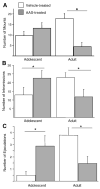Anabolic androgenic steroids differentially affect social behaviors in adolescent and adult male Syrian hamsters
- PMID: 18201704
- PMCID: PMC2883314
- DOI: 10.1016/j.yhbeh.2007.11.004
Anabolic androgenic steroids differentially affect social behaviors in adolescent and adult male Syrian hamsters
Abstract
Anabolic androgenic steroids (AAS) are synthetic derivatives of testosterone used by over half a million adolescents in the United States for their tissue-building potency and performance-enhancing effects. AAS also affect behavior, including reports of heightened aggression and changes in sexual libido. The expression of sexual and aggressive behaviors is a function of complex interactions among hormones, social context, and the brain, which is extensively remodeled during adolescence. Thus, AAS may have different consequences on behavior during adolescence and adulthood. Using a rodent model, these studies directly compared the effects of AAS on the expression of male sexual and aggressive behaviors in adolescents and adults. Male Syrian hamsters were injected daily for 14 days with either vehicle or an AAS cocktail containing testosterone cypionate (2 mg/kg), nandrolone decanoate (2 mg/kg), and boldenone undecylenate (1 mg/kg), either during adolescence (27-41 days of age) or in adulthood (63-77 days of age). The day after the last injection, males were tested for either sexual behavior with a receptive female or agonistic behavior with a male intruder. Adolescent males treated with AAS showed significant increases in sexual and aggressive behaviors relative to vehicle-treated adolescents. In contrast, AAS-treated adults showed significantly lower levels of sexual behavior compared with vehicle-treated adults and did not show heightened aggression. Thus, adolescents, but not adults, displayed significantly higher behavioral responses to AAS, suggesting that the still-developing adolescent brain is more vulnerable than the adult brain to the adverse consequences of AAS on the nervous system and behavior.
Figures


References
-
- Ahima RS, Harlan RE. Regulation of glucocorticoid receptor immunoreactivity in the rat hippocampus by androgenic–anabolic steroids. Brain Res. 1992;585 (1–2):311–314. - PubMed
-
- Albert DJ, Petrovic DM, Walsh ML, Jonik RH. Medial accumbens lesions attenuate testosterone-dependent aggression in male rats. Physiol Behav. 1989;46 (4):625–631. - PubMed
-
- Andersen SL. Trajectories of brain development: point of vulnerability or window of opportunity? Neurosci Biobehav Rev. 2003;27 (1–2):3–18. - PubMed
-
- Bahrke MS, Yesalis CE. Abuse of anabolic androgenic steroids and related substances in sport and exercise. Curr Opin Pharmacol. 2004;4 (6):614–620. - PubMed
-
- Bahrke MS, Yesalis CE, III, Wright JE. Psychological and behavioural effects of endogenous testosterone levels and anabolic–androgenic steroids among males. A review Sports Med. 1990;10 (5):303–337. - PubMed
Publication types
MeSH terms
Substances
Grants and funding
LinkOut - more resources
Full Text Sources
Medical

